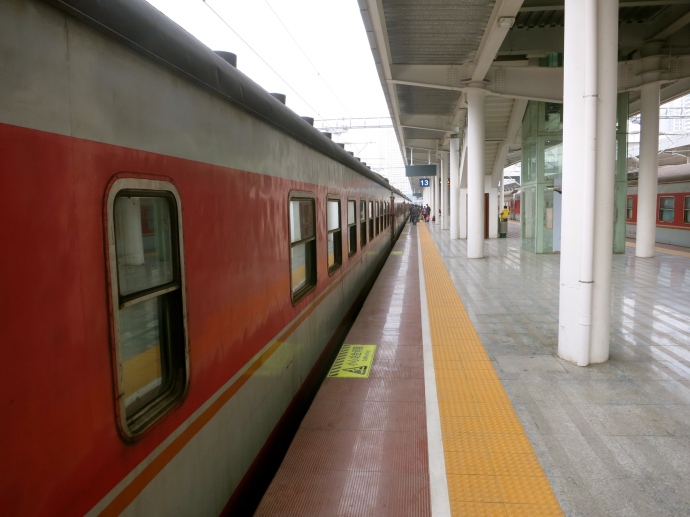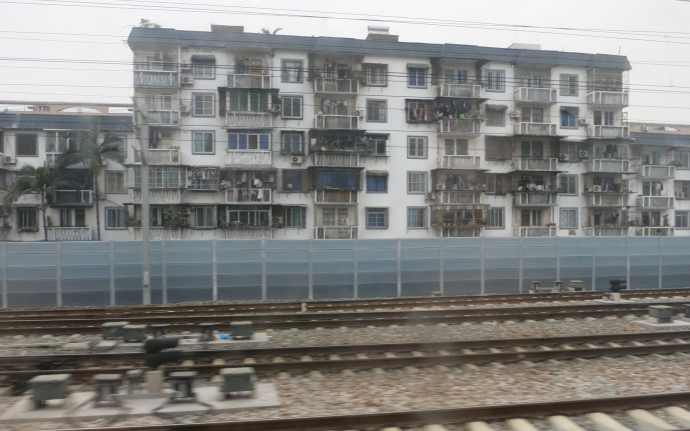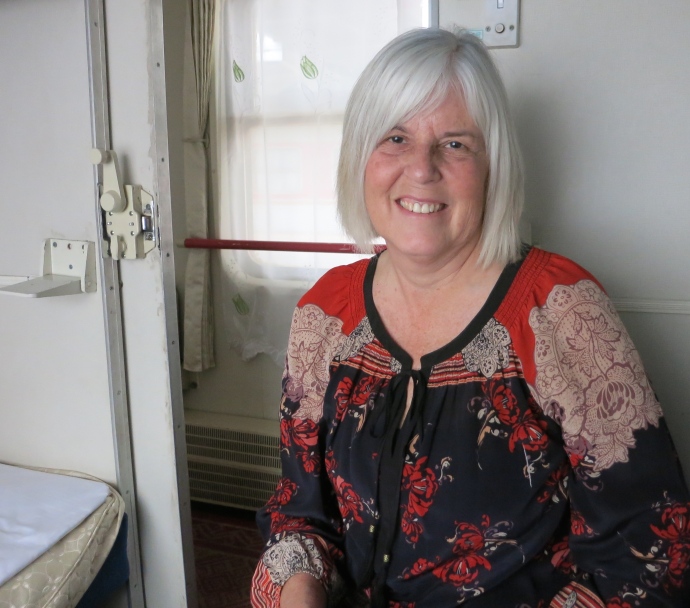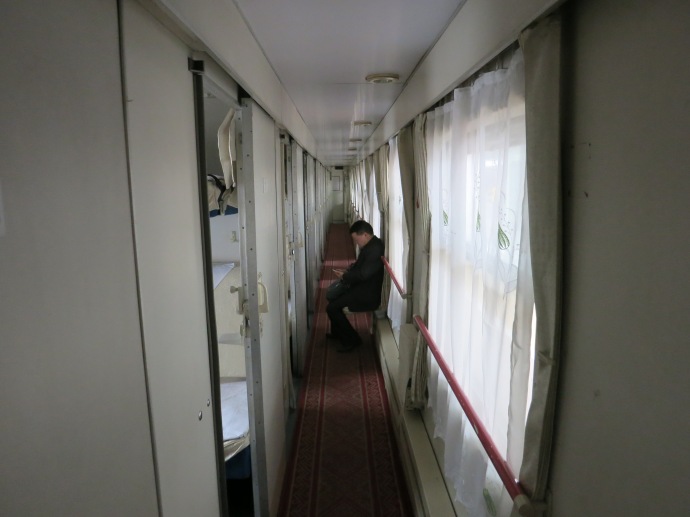In late January, my husband Mike traveled from Virginia to visit me here in China. We went to Hunan province, where we visited Fenghuang and Zhangjiajie, and to Guangxi, where we visited Guilin and Yangshuo. I was disappointed for him because we had horrible weather for nearly the whole time he was here. His one and only experience of China was a rainy, fog-enshrouded, cold and gloomy one. In his reflections below, you can see that despite our hardships, he managed to see the experience as a positive one. This was more than I could say for myself, but then I’ve seen better days in China.
Here are Mike’s reflections, along with some of the photos he took.
——————————————————–
After Cathy decided to go to China to teach this year she suggested that I should plan on visiting and traveling with her on one of her breaks. My initial reaction was less than enthusiastic. My first inclination is to plan relaxing, stress-free, outdoorsy vacations away from crowds and the fast-paced life I deal with in the DC suburbs. After giving the idea some thought and talking more with Cathy, I committed, leaving the planning to her, providing feedback on trip options when asked. I am an avid reader, like Cathy, and have an interest in cultural anthropology and world history, which I get from a fictional and non-fictional perspective. In addition to having the opportunity to spend some time with my nomad wife, I would see firsthand how one in five people on our planet live.
I knew from the outset that this trip would be a challenge, starting and ending with the long time-zone crossing flights halfway around the globe. From Cathy’s early travel experiences in China I knew that our in-country travels would not be easy. Neither of us are much on tour groups, preferring the freedom to move about at our own pace, surrounded by local folks, being forced to figure things out on our own. That‘s half the adventure. The apprehension we felt every time we ventured out to our next destination was rewarded with a sense of accomplishment and relief upon arrival. I came with no expectations other than to relish the uniqueness of China. Cathy put a lot of time and energy into our itinerary, hoping to show me the picturesque and historic side of Guangxi and Hunan provinces. You seasoned travelers understand the tenuous balance between trying to visit as many places as possible within a tight time window and allowing oneself the time to soak in the essence of each layover, and recharge, before diving in to the next adventure. I felt like we achieved that balance.
Cathy was very honest on her blog in describing her disappointment with the cool damp weather during my visit. Besides yielding a series of fog shrouded photos for her blog, she was sad for me. I am sure that many travel bloggers portray only the positive aspects of their trips, which is not reality. You have to accept and learn to deal with weather and other circumstances that don’t go your way. I like how Cathy freely shares her personal frustrations in her blogs.
Yes, I would have enjoyed some clear sunny days, but I was so alert to the sights, sounds, smells and the way of life wherever we went that the weather had much less of an impact on me than Cathy. The mist encased quartz-sandstone pillars of Zhangjiajie and the limestone karsts of Yangshuo looked whimsical and mysterious. The one rainy day where we didn’t go trekking was spent lounging in bed reading and treating ourselves to a muscle relaxing massage. That was just what we needed, some down time to recover.
I was constantly fascinated by assorted modes of transportation, the unified flow of scooters, bikes and buses on the crowded streets and dusty rural roads, the lack of heat throughout, the family way of life in the shops, service bays, and eateries, the variety of critters and body parts offered on the menus, the placid acceptance of a quality of life that few westerners could imagine, the third world toilets, the often derelict trains and train stations, the rural communal hamlets we cycled through, the villagers laboring in the never-ending fields, and the general friendliness of the people we encountered.
I wanted to see where Cathy lived, where she worked, the students she taught, where she shopped and ate, how she traveled, the soul and spirit of the bustling cities, the steady march of the rural farms, so I could get a sense for the environment she moved about in during her life in Guangxi. Thankfully those impressions will now be with me for the rest of her stay in Nanning, sensory impressions catalogued and brought to mind as she shares with me her weekly recap on Skype. Instead of her face and the stories she tells in words, I will see much more.
There are so many memories and images that come to mind from our two-week excursion, all fascinating to me, many of which Cathy has already shared in her blog. Some of these memories can’t be captured by pictures and words. They were moments of interaction, on some level, with others, in a land where one feels so isolated, despite being surrounded by 1.3 billion people. The thirteen hour plane ride seated next to a mother and her young son from Mongolia on their return trip from studying at the international school in Miami, Florida, the respectful sharing of a small train compartment for twelve hours with two young strangers, the prideful smile on the face of our dumpling lady in Fenghuang who was thrilled to see us show up for breakfast three mornings in a row, the conversation with a young woman, employed in international sales, on our boat ride on Baofang Lake, the engaging conversation with Duco, the young Dutch backpacker, on our bus ride to Yangshuo, the family we traveled with on our Li river bamboo raft, and the many challenging interactions arising from the language barrier at every twist and turn.
In one of Cathy’s blogs about Alex’s time in China she mentions a tension-filled afternoon. This is to be expected, in less than ideal travel situations and close quarters, as individual expectations collide with circumstances and each other. I suppose the key to traveling with someone else, successfully, is to recognize that this will happen and what to do when it does happen. I think in Alex and Cathy’s case, space and time was all they needed, and by the evening they were fine. It was surprising to me given all of the traveling we did and the inclement weather we encountered that we didn’t really encounter any moments of tension. Perhaps I’ll chalk that up to my laid back nature; HA! Just joking Cathy, I know it takes two to make this happen.
In looking back on my two weeks in China, followed by Alex’s two weeks, followed by Cathy’s trip to Myanmar, I am amazed at Cathy’s stamina, especially in light of the cough she came down with on our trip. Both Alex and I were exhausted after our short journeys. I can’t even begin to imagine doing that for six weeks. Cathy is like the Energizer Bunny, she keeps going and going and going!!!
As I left China I realized that this was truly a once-in-a-life experience. It is an experience that for myself, and for Alex, will resurface in years to come as we put global events into perspective, as a result of having the opportunity to glimpse a way of life so different from our own. I am thankful for that opportunity.











































































































































Recent Comments